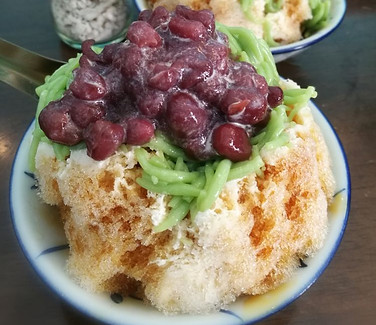

Malaysian Cuisine
Malaysian cuisine, just like its people, is divided into Malay, Chinese and Indian
and is still prepared by their own unique ways.

Nasi Lemak
No other dish in Malaysia is as famous as nasi lemak.
It consists of rice cooked in coconut milk that is traditionally served with anchovies, cucumbers, peanuts, and boiled eggs. The dish is rounded up with the addition of a spicy chili paste called sambal.
Char Koay Teow
Char kway teow is one of the most popular street dishes in Malaysia. Despite numerous regional varieties, it is usually made with flat rice noodles, shrimps, eggs, cockles, bean sprouts, chives, and Chinese sausage. All the ingredients are usually fried and coated in soy sauce, while some versions also incorporate shrimp paste, garlic, fried pork lard, and sometimes even yellow wheat noodles.


Penang Laksa
Ranked #7 in CNN Go "World's 50 Best Foods" list in 2011 - and it's the only Malaysian dish included. The perfect blend of spicy, sweet, savory, and umami flavors, penang laksa is a popular Malaysian street food. This hearty noodle soup is made with poached mackerel (or sardines), tamarind, lemongrass, and chili peppers as the base ingredients.
Penang Hokkien Mee
Penang version of the dish known as Hokkien mee is significantly different from the varieties that can be found in other parts of Malaysia and Singapore. Often referred as prawn mee, the dish consists of a broth that is flavored with prawns and pork ribs, and which comes topped with ingredients such as sliced pork, rice and wheat noodles, bean sprouts, prawns, kangkong (water spinach), fried shallots, and boiled eggs.


Bak Kut Teh
This hearty dish stems from the Chinese culinary tradition. In its simplest form, it consists of various pork cuts that are cooked in a flavorful broth which is seasoned with star anise, cinnamon, garlic, and fennel. It is commonly complemented with tofu puffs or mushrooms and usually comes served with several condiments.
Apam Balik
This sweet turnover pancake comes under various names throughout Malaysia, Indonesia, Brunei, and Singapore. Regardless of the location, it can be prepared either in a thin and crispy variety or as a thick and soft pancake. Traditional fillings typically include a combination of ground or roughly chopped peanuts, sugar, and butter, but the modern varieties may include anything from corn, chocolate chips, and raisins to grated cheese or condensed milk.


Mee Goreng
Mee goreng is a versatile stir-fry noodle dish from the Maritime Southeast Asia region. It is a spicy-savory course that pairs the noodles with a combination of fish cakes, chicken, prawns, garlic, scallions, tomato sauce, curry spice, sweet soy sauce, boiled potatoes, and eggs. For toppings, the most commonly used are red chilies, crispy fried onions, and lime juice.
Hainanese Chicken Rice
The Hainanese chicken rice is a dish that consists of succulent steamed white chicken cut into bite-size pieces and served on fragrant rice with some light soy sauce. The dish is topped with sprigs of coriander leaf and sesame oil, and accompanied by a garlic-chilli dip.


Satay
Satay is small pieces of spice marinated meat (usually lamb, beef, chicken) skewered with a thin wooden stick cooked by grilling over a trough of open charcoal fire. It is traditionally served with satay sauce, which is a fresh peanut sauce, a must for any true satay lover.
Cendol
A dessert much like ice-kacang with the difference that instead of shaved ice, there is an abundance of coconut milk mixed with palm sugar syrup, topped with green rice jelly and other condiments. A creamy alternative to the ais kacang for those with sensitive teeth.


Roti Canai
Roti canai is a traditional Malaysian pan-fried flatbread made with flour, water, eggs, and fat. The dough for roti canai is repeatedly folded, so the final product has a layered texture, a soft interior, and a crispy outer layer. The most common fat used in roti canai is ghee, the traditional Indian clarified butter.
Nasi Kandar
This classic Malaysian dish combines steamed rice and an assortment of different curries, sides, and condiments. The rice is occasionally seasoned, and the choice of curries includes various combinations of vegetables, meat, or seafood. Traditionally associated with Penang, the dish was initially developed among the Indian community who brought their culinary traditions to Malaysia.


Otak-Otak
This fish paste mixture of spices and diced onions is loosely wrapped in a banana leaf and barbecued over charcoal until the pinkish contents become warm and the leaves are slightly charred. No fuss or frills when it comes to eating -- picking at it straight from the leaf is the only way to do it.
Kolo Mee
Kolo mee is a traditional Malaysian dish hailing from Sarawak. This simple dish consists of egg noodles that are tossed in sauce and topped or served with sliced barbecued pork (char siu), minced pork, and fried onions. In hawker stalls, the dish is often made with lard. It can be additionally enriched with fish balls, wontons, and vegetables such as choy sum (a leafy vegetable).


Ikan Bakar
Ikan bakar means “grilled fish”. It refers to Malasyian and Indonesian fish dishes that are seasoned with a spice marinade and wrapped in banana leaves before being quickly grilled over a hot charcoal flame. It can be made with pretty much any type of fish such as freshwater gourami, carp, mackerel, red snapper, rabbitfish, and stingray.